Header logo
header top contact widget
Tooth Replacement
A “Lecture-Free” Look At Cigarettes & Your Smile
Posted on Oct 11, 2023 by William J. Claiborne, DDS MS
In this article, I’m going to address cigarette smoking as it affects oral health. This is not intended to lecture or chastise an adult for making a choice to smoke or those caught up in the addictive grip of nicotine. My goal is to relay factual information regarding oral health for smokers so they can better protect their smiles.
Because I’m a native North Carolinian, I’ll begin by sharing some information on our State, as provided by 2018 stats from the CDC (Centers for Disease Control & Prevention).
In 2018, the percentage of adults in North Carolina who smoked was reported as 17.4% (of every 100 adults). The CDC shared findings of all states, with smoking ranged from nearly 9 of every 100 adults in Utah (9.0%) to 25 of every 100 adults in West Virginia (25.2%).
They also shared that cigarette smoking was lowest among those with a graduate degree (3.2%) and highest for those who had only achieved a GED certificate (30.7%). Those with a high school diploma showed a lower percentage of nearly half of the GED level adults at 17.1%.
As an Asheville periodontal dental specialist, smoking is a particular concern since many people are unaware of the oral health risks. While many smokers are familiar with the risks smoking poses related to cancer and other diseases, smoking is also terribly harmful to your smile.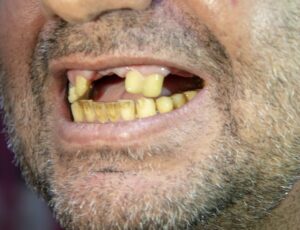
For instance, smokers have a greater risk of periodontal (gum) disease. The drying effect that smoking has on the soft tissues in the mouth offers an ideal breeding ground for oral bacteria. This enables easier entry of oral bacteria into the structures that support tooth roots.
According to the Centers for Disease Control & Prevention (CDC), a smoker has twice the risk for gum disease compared to that of a nonsmoker.
As oral bacteria thrive and reproduce in the mouth, gum tissues become tender and inflamed. These are signs of gingivitis, the beginning stage of gum disease.
Gum disease at this stage can cause persistent bad breath, swollen gums and gums that bleed easily when brushing. As it progresses, gum tissues turn red or purple from inflammation. Pus pockets may form at the base of some teeth. This advanced stage is known as periodontitis.
Eventually, the infectious bacteria penetrate below the gum line and attack supporting bone and the tissues surrounding tooth roots. This can cause teeth to loosen and eventually require removal. Gum disease is the nation’s leading cause of adult tooth loss.
Losing teeth is detrimental to your overall health and not a normal part of the aging process. Studies have shown that people who wear dentures die an average of ten years earlier than those who keep their natural teeth.
Denture wearers also have higher incidences of pneumonia, and worse. A 2015 report by NBC News shared findings surrounding dentures and MRSA biofilm. The report included a dental specialist’s warning that, “Concern about biofilms on dentures is growing as researchers continue to identify links between oral bacteria and heart disease, chronic obstructive pulmonary disease or COPD, and respiratory diseases, including aspiration pneumonia.”
Many smokers are aware that they have stained teeth and more-frequent bad breath than non-smokers. They also have slower healing periods after procedures such as extractions, gum treatment and oral surgery.
Although a hygienist may go slowly and gently, dental cleanings are typically less comfortable for smokers. This is because smoking causes a greater buildup of plaque. With gum tissues already tender from the bacterial irritation of plaque, removing buildup from between and around the base of teeth adds to the discomfort of inflamed tissues.
According to the American Dental Association (ADA), smoking increases the risks of oral cancer, lesions inside the mouth, enamel erosion and tooth loss in addition to periodontal (gum) disease.
If you vape, remember that nicotine in any form is a hazardous force in the mouth. And the vapor itself is not safe for oral health.
Vaping (using e-cigarettes) delivers nicotine through an inhaled mist. Although the vapor is generally not labeled as “dangerous,” one study of some e-cigarette products found the vapor contains known carcinogens and toxic chemicals, including, propylene or polyethylene glycol, glycerin, and additives. And, its nicotine is no less harmful to the user as that delivered via cigarette smoke.
Unfortunately, many cigarette users switch to vaping based on the perception that “e-cigs” are a safer alternative. For those hoping to wean themselves off cigarettes through this switch, very few achieve that goal as a result.
A 2018 report by the National Academy of Sciences, Engineering, and Medicine concluded there was “evidence that e-cigarette use increases the frequency and intensity of cigarette smoking in the future.”
Although the focus in this article is meant to be on oral health, allow me to reiterate some of the benefits of “kicking the habit” …
• Smokers have a decreased life expectancy of an average of 10–15 years compared to non-smokers.
• Smoking is linked to nearly a third of all cancer diseases and deaths.
• Pregnant women who smoke have a higher risk for first-trimester spontaneous abortion, preterm births, low birth weight babies and sudden infant death syndrome (SIDS).
• Women who smoke are at risk for early menopause while men who smoke are more at risk for impotency.
• People who breathe in your “second hand” smoke (what you exhale) are subjected to over 50 known carcinogens and other harmful chemicals.
For those who are able to give up smoking, the effort is well worth it. The positive effects can be felt almost immediately. In about 48 hours, damaged nerve endings begin to restore. The sense of smell and taste begin to return to normal.
“Quitters” also notice their breathing is easier in about 3 days and they have fuller air intake. Oral health improves within 2 weeks as blood circulation in the gums and teeth returns to nearly that of non-smokers. Heart attack risk also declines with blood flow greatly improving. Activities are easier and the constant smokers cough is gone.
 In our Asheville periodontal office, our goal – for every patient – is to help each achieve optimal oral health and a smile he or she is proud to share. For those who smoke, we make individualized recommendations so the potential for achieving this is favorable.
In our Asheville periodontal office, our goal – for every patient – is to help each achieve optimal oral health and a smile he or she is proud to share. For those who smoke, we make individualized recommendations so the potential for achieving this is favorable.
If tooth loss has already occurred, we are specialists in the treatment of all stages of gum disease and in the diagnosis and placement of dental implants. We will be happy to discuss the dental implant system that may be best for your needs.
Or, if dental fear or anxiety have kept you from receiving regular dental care, ask us about oral or IV sedation (“twilight sleep”). These sedatives are delivered by an MD of anesthesia for your optimal safety and comfort. And, in all procedures, we make patient comfort a high priority.
Call 828-274-9440 to schedule an examination.
Sources:
https://www.cdc.gov/tobacco/campaign/tips/diseases/periodontal-gum-disease.html
https://www.sciencedaily.com/releases/2016/11/161116101821.htm
https://www.nbcnews.com/healthmain/dirty-dentures-dangerous-mrsa-may-be-lurking-dentists-say-662637
https://www.cdc.gov/tobacco/basic_information/e-cigarettes/index.htm
Common Contributors to Tooth Loss
Posted on Sep 11, 2023 by William J. Claiborne, DDS MS
Our natural teeth seem hard and solid, able to endure much over the span of a lifetime. However, as we all know, teeth can be knocked out due to accidents or injury and lost due to becoming overly decayed, fractured, infected and – the leading cause – periodontal (gum) disease.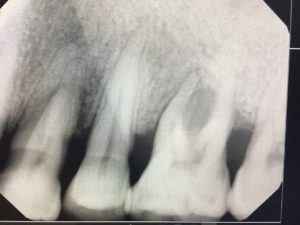
Your gum tissues serve as protection for the tooth structures you cannot see – the tooth roots and bone and tissues supporting the roots. And, teeth need these bone structures to stay healthy and vice versa; the bone structures beneath the gums need the presence of the roots to stay healthy.
The jaw bones are kept healthy by tooth roots that provide stimulation to the bone as well as nourishment that runs through the tooth’s interior.
When a tooth is removed, so is the stimulation and nourishment to that area of the jaw bone. Without it, the bone begins to shrink. As it declines in height, adjacent teeth are more vulnerable to loss. Statistics show that teeth adjacent to areas where natural teeth are missing will be the most likely to be lost next.
According to the Center for Disease Control & Prevention (CDC), 69% of adults between ages 35 – 44 have lost at least one permanent tooth. By age 50, Americans are missing an average of 12 teeth. For adults between the ages of 65 – 74, 26% are missing all of their natural teeth. That’s over one-fourth of the adult population over age 65.
Because of the strength and seemingly rock-solid presence of teeth, it may be assumed they’ll last for a lifetime. And, they can. Natural teeth can and should last a lifetime with proper maintenance and care. However, certain things can contribute to tooth loss; some of these may not be well known.
These include:
GUM DISEASE – Signs and symptoms of gum disease are:
• Red, swollen or tender gums
• Seeing blood in the sink when brushing
• Receded gums
• Loose or separating teeth
• Pus pockets on gum tissues
• Sores in the mouth
• Persistent bad breath
When these indications exist, it is important to seek periodontal treatment as soon as possible. Gum disease only worsens without treatment, requiring more time and expense to rid this serious, even deadly, inflammatory disease.
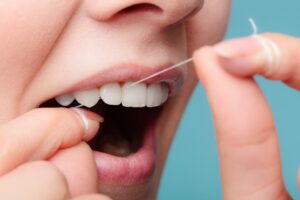 NOT FLOSSING – While tooth brushing helps to keep oral bacteria levels in the mouth to manageable levels, daily flossing is also recommended as a preventative way to keep cavities and gum disease at bay. Still, 70% of the American adult population do not floss daily. Even worse, about a third of Americans admit to never flossing (39% of men and 27% of women who do not).
NOT FLOSSING – While tooth brushing helps to keep oral bacteria levels in the mouth to manageable levels, daily flossing is also recommended as a preventative way to keep cavities and gum disease at bay. Still, 70% of the American adult population do not floss daily. Even worse, about a third of Americans admit to never flossing (39% of men and 27% of women who do not).
SMOKING – According to the Centers for Disease Control & Prevention (CDC), a smoker has twice the risk for gum disease compared with that of a nonsmoker. (https://www.cdc.gov/tobacco/campaign/tips/diseases/periodontal-gum-disease.html)
AGING – With age, the body becomes less efficient in maintaining itself. Due to hormone changes and being less hydrated, joints wear down, skin loses subtlety and muscle mass and strength declines. The same is true with teeth, especially as gum tissues dry out. This means their tight, protective grip around the base of teeth loosens and pockets can easily for between teeth. All these factors contributor to higher risks of gum disease and tooth loss.
ORAL DRYNESS – The tissues inside the mouth need to be kept moist. Saliva flow is designed to do this. However, with age, the flow of saliva is less plentiful. Just as the skin and hair get drier with age, the mouth endures this same consequence. When saliva flow is less efficient at rinsing bacteria from the oral cavity (inside of the mouth), bacteria grow at a more rapid rate. This means bacteria accumulation occurs more frequently than twice-a-day brushing can control.
MEDICATIONS – The average adult in the 65-79 age group has over 27 prescriptions filled each year. (https://www.statista.com/statistics/315476/prescriptions-in-us-per-capita-by-age-group/). Many meds have the side effect of oral dryness or increased bleeding, including some herbal supplements. For example, Ginkgo Biloba and Vitamin E can act as blood thinners. When combined with aspirin, the combination may cause difficulties in blood clotting.
To halt the potential for tooth loss if you are already missing teeth, dental implants are recommended. They actually protect the health of neighboring teeth. In addition to helping the supportive bone structures retain bone mass, teeth supported by implants do not rely on the support of crowned (or ‘capped’) teeth on both sides. This means the integrity of adjacent teeth is preserved.
Dental implants come in over 40 different types designed to accommodate various challenges and preferences. This is one reason (of many) that a periodontist is an ideal choice for the diagnosis and placement of your implants. Our speciality understands the complete spectrum of implant systems. While some implant systems may be ideal for your needs, others may not. And, the choice of which will achieve your goals is not limited to just those types a non-specialist knows how to place.
For example, some dental implants provide you with a non-removable (“fixed”) option while others may involve removable teeth. Additionally, the proper selection of your dental implants may greatly save you in treatment fees.
For example, the All-On-4 dental implant system needs only 4 implants per arch, and can be placed in shallow bone. The treatment fees are less since the number of implants is low and the need for bone regeneration for severe bone loss may not be required. For these reasons, a periodontist may be able to help you achieve your tooth replacement goals within a budget you can manage.
Our Western NC periodontal dental office features some of the industry’s most advanced technology, which helps to optimize success rates, shorten treatment time, and enhance comfort. This includes 3-D Cone Beam imaging, which is ideal for diagnoses and treatment planning. These amazing images provide a clear view of the upper and lower jaw (including nerve canals) in a process that is quick, painless and at minimal radiation levels.
We also have a computerized Dental Implant Placement system for pre-surgical positioning of dental implants. Using a 3D model of the patient’s jaw, a template is developed for the most conservative treatment process needed, even for complex cases. This minimizes disruption of gum tissues and targets implant placement at ideal depths and angles.
Because we make patient comfort one of our highest priorities, we offer several sedation options, including oral and IV sedation. Oral sedation is a pill that helps patients relax. It also has an amnesiac effect, leaving most with little or no memory of treatment afterward. I.V. sedation (also known as “twilight sleep”) places the patient in a deeper sleep state and erases memory of the procedure. It is administered by a Medical Doctor (MD) who is a board certified Anesthesiologist.
If you have lost teeth (or struggle with a denture or partial) and are considering dental implants, begin with a consultation appointment. Call 828-274-9440. New patients are always welcome.
Grow Older With A Confident Smile That Is An Asset To Your Well-Being
Posted on Jul 27, 2023 by William J. Claiborne, DDS MS
Oliver Wendell Holmes, an associate justice of the U.S. Supreme Court from 1902 – 1932, once said, “Old age is always fifteen years older than I am.”
 For people who’ve reached “a certain age,” it becomes clear that the advantages of aging (such as having more confidence and living life at a slower pace) are mixed with many challenges, mostly regarding health.
For people who’ve reached “a certain age,” it becomes clear that the advantages of aging (such as having more confidence and living life at a slower pace) are mixed with many challenges, mostly regarding health.
From aching joints to loss of muscle strength to poor eyesight and hearing loss, the aging process comes with health challenges that seem to grow in number and severity with each passing year. Sadly, increased risk of tooth loss is also part of the process.
Depending on the retention of wisdom teeth, a full set of adult teeth should be 28 to 32. However, in a five-year study by the National Health & Nutrition Examination Survey, Americans ages 75 and over were missing over 22 natural teeth with over 26% having no remaining teeth (known as being edentulous).
While tooth loss is often perceived as a normal part of the aging process, it is not. Keeping one’s teeth throughout a lifetime is very possible. The health benefits of maintaining natural teeth include, among many others, living a longer life.
Healthy teeth rely on a healthy foundation — your gums. Good oral health has been shown to reduce risks for serious health conditions (including heart disease, stroke, and some cancers) elsewhere in the body. In addition to lowering a number of health risks, keeping your natural teeth is necessary for proper biting, sufficient chewing, digestional health and nutritional intake.
It has also been shown that wearing dentures is a poor method of replacing natural teeth. Even though they recreate the appearance of teeth and restore function (to varying extents), dentures can actually contribute to long-term problems.
Natural tooth roots help to nourish and stimulate the jaw bones that are the supporting structures of teeth. Without them, the bones begin to shrink. Known as “resorption,” this process of bone mass decline can eventually lead to tooth loss. Once resorption begins,, it continues at an ever-increasing cases year after year.
Tooth loss also causes a domino effect of sorts. Statistics show that adjacent teeth beside an area of tooth loss have the highest risk of being the next to be lost.
And the problems associated with dentures continue. The gum-colored base of dentures is porous. This surface provides oral bacteria with tiny hideouts that are breeding grounds for high levels of bacteria. Denture wearers have higher incidences of respiratory problems, including susceptibility to pneumonia. Studies have shown that senior adults who also sleep in their dentures have even higher risks.
Wearing your dentures for prolonged periods of time (such as while you sleep) coupled with the aging process itself can lead to Denture Stomatitis. This condition causes redness, swelling and tenderness in the mouth. While it is most common among denture wearers, it can also occur from a broad spectrum of antibiotics.
Nearly 89% of adults ages 65 and older report they are currently taking any prescription medicine. More than half of adults 65 and older (54%) report taking four or more prescription drugs (compared to 32% of adults 50-64).
While a number of both prescribed and OTC medications include the side effect of oral dryness for any age, age-related reductions in salivary production are more severe for older adults, causing irritation to oral tissues.
Medications including antihistamines, blood pressure medications, decongestants, pain medications, diuretics and antidepressants typically cause dry mouth, which can create inflammation and higher susceptibility to infection.
The aging process causes the condition of “dry mouth.” Saliva plays an important role in maintaining good oral health. A healthy saliva flow makes it easy to talk, swallow, taste, and digest food. A reduction in saliva flow can increase plaque accumulation as well as the risk of developing periodontal disease.
Referred to as gum disease, this bacteria accumulation can lead to tooth decay, mouth sores and oral infections. Inadequate saliva can contribute to bad breath, dry and cracked lips, cause the fit of dentures to become uncomfortable, and result in higher oral infection risk.
An emphasis on maintaining good oral health needs to be front and center for older adults along with their overall health care commitment. Fortunately, good oral health is easy to achieve. Twice-daily brushing, daily flossing and having 6-month dental exams and cleanings can help to minimize problems and address those that do occur at their earliest stages.
It is also important to keep your mouth moist. Drink plenty of water throughout the day. Limit foods and beverages that are caffeinated, which are drying to oral tissues. These include coffee, tea, colas and chocolate as well as spicy foods. If you take medications that have drying side effects, use an oral rinse designed to replenish moisture. Also, chew sugarless gum to help promote saliva flow.
Your diet is an important part of a healthy mouth. Evaluate your food intake carefully. Begin by limiting carbs and sugar. While all foods trigger an acid attack in the mouth for nearly 30 minutes after eating, sugar and carbs super-charge the reproduction of oral bacteria.
When teeth are lost, adults encounter a complicated set of issues – and costly challenges that can reach far beyond the mouth. As a Periodontist, I’ve seen how simple measures can save people greatly in treatment time and expense AND prevent problems like gum disease, cavities and tooth loss.
According to Woody Allen, “You can live to be a hundred if you give up all things that make you want to live to be a hundred.” Your smile should be one of your best assets throughout your lifetime, complementing appearance and as an advantage to your overall health. Don’t let the detrimental impact of tooth loss and risks associated with gum disease make you look and feel old.
If you have begun to lose natural teeth, let us help you halt the process! We can also discuss replacing them with dental implants with our specialized skills in the diagnosis and placement of dental implant.
Call 828-274-9440 to schedule a consultation to discuss how you can regain your oral health for a lasting, healthy smile!
Sources:
https://www.nidcr.nih.gov/research/data-statistics/tooth-loss/seniors
https://www.kff.org/health-reform/issue-brief/data-note-prescription-drugs-and-older-adults/
https://my.clevelandclinic.org/health/diseases/21702-denture-stomatitis
Six Reasons To Have Your Dental Implants Placed By A Periodontist
Posted on Jul 12, 2023 by William J. Claiborne, DDS MS
A periodontist is a dental specialist who is often in the background of various dental procedures. Yet, we are in the forefront when it comes to specialized skills that support specific treatment needs.
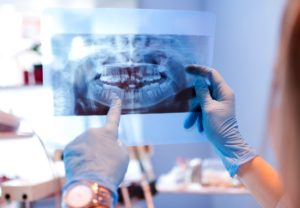 Most patients are referred to our Asheville periodontal dental office by general dentists and dental specialists to provide certain aspects of dental treatment, which may involve our skills in cosmetic dentistry, dental implants, and treating all stages of gum disease.
Most patients are referred to our Asheville periodontal dental office by general dentists and dental specialists to provide certain aspects of dental treatment, which may involve our skills in cosmetic dentistry, dental implants, and treating all stages of gum disease.
A periodontist has advanced training to properly diagnose and treat all stages of periodontal (gum) disease (including gingivitis and periodontitis) as well as placement of dental implants. In addition, periodontists are particularly skilled in performing cosmetic periodontal procedures to repair gum-related disparities such as a “gummy smile” or varying gum arches that “jumble” a smile line.
A periodontist receives an additional 3 years of training after 4 years of undergraduate school and 4 years of dental school. This long, rigorous pursuit of the periodontal specialty requires the individual to be highly committed to the advanced care he or she will provide. It is our goal to help people achieve good oral health, a confident smile they love to share, and prevent tooth loss that can result from diseases of the gums.
Dental implants are now seen as the preferred option for tooth replacement. They come in over 40 different types designed to accommodate various challenges and preferences. But, why should you have your dental implants chosen and placed by a periodontist? After all, some dentists perform this in addition to their general dentistry services.
Below are 6 reasons our dental implant patients have particular advantages…
(1). With specialized skills, a periodontist is especially respectful to oral tissues as sensitive layers that have an important role in the appearance of a smile and the health of teeth. Utilizing these skills, a periodontist can help to minimize incisions while effectively treating each area in the mouth.
(2). Rather than be limited to just one or two dental implant systems that were taught in a “crash course” by the implant manufacturers, our speciality understands the complete spectrum of implant systems. Some may be ideal for your needs while others may not. Some provide you with a non-removable (“fixed”) option while others may involve removable teeth. Our specialized skills give you the best choices you should have.
(3). Additionally, the proper selection of your dental implants may greatly save you in treatment fees. For example, the All-On-4 dental implant system needs only 4 implants per arch, and can be placed in shallow bone. The treatment fees are less since the number of implants is low and the need for bone regeneration for severe bone loss may not be required. For these reasons, a periodontist may be able to help you achieve your tooth replacement goals within a budget you can manage.
(4). In our Western NC periodontal dental office, our advanced technology includes 3-D Cone Beam Imaging. This is ideal for diagnoses and treatment planning through images that provide a clear view of the upper and lower jaw (including nerve canals), with rotations that show sagittal, axial, and coronal planes. The imaging process is quick, painless and at minimal radiation levels.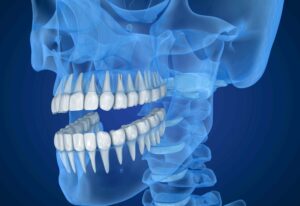
(5). Another feature is our Computerized Dental Implant Placement system. This advanced technology is designed for pre-surgical positioning of dental implants that uses a 3D model of the patient’s jaw. Once the implant type is selected, a template is developed for optimal treatment success, even for complex cases. This minimizes disruption of gum tissues and targets implant placement at ideal depths and angles. Thus, treatment success rates are higher with faster (and more comfortable) healing time.
(6). Optimal comfort for our patients has always been a priority. For many, a desired level of comfort and relaxation includes sedation options. Here, we offer several sedation options, including oral and IV sedation.
Oral sedation is a pill that helps patients relax. It also has an amnesiac effect, leaving most with little or no memory of treatment afterward. IV sedation (also known as “twilight sleep”) places the patient in a deeper sleep state and erases memory of the procedure. It is administered by a Medical Doctor (MD) who is a board certified Anesthesiologist.
With both sedation options, patients are closely monitored with advanced safety equipment throughout treatment.
If you are considering dental implants, you may wish to begin with a consultation appointment. During this time, we can explain the vast difference in comfort, treatment time, and success available through our specialized skills and extensive technology.
Call 828-274-9440 to schedule. New patients are always welcome and a referral is not always required.
Recent Posts
Categories
Archives
- September 2024
- August 2024
- July 2024
- June 2024
- May 2024
- April 2024
- March 2024
- February 2024
- January 2024
- December 2023
- November 2023
- October 2023
- September 2023
- August 2023
- July 2023
- June 2023
- May 2023
- April 2023
- March 2023
- February 2023
- January 2023
- December 2022
- November 2022
- October 2022
- September 2022
- August 2022
- July 2022
- June 2022
- May 2022
- April 2022
- March 2022
- February 2022
- January 2022
- December 2021
- November 2021
- October 2021
- September 2021
- August 2021
- July 2021
- June 2021
- May 2021
- April 2021
- March 2021
- February 2021
- January 2021
- December 2020
- November 2020
- October 2020
- September 2020
- August 2020
- July 2020
- June 2020
- May 2020
- April 2020
- March 2020
- February 2020
- January 2020
- December 2019
- November 2019
- October 2019
- September 2019
- August 2019
- July 2019
- June 2019
- May 2019
- April 2019
- March 2019
- February 2019
- January 2019
- December 2018
- November 2018
- October 2018
- September 2018
- August 2018
- July 2018
- June 2018
- May 2018
- April 2018
- March 2018
- February 2018
- January 2018
- December 2017
- November 2017
- October 2017
- September 2017
- August 2017
- July 2017
- June 2017
- May 2017
- April 2017
- March 2017
- February 2017
- January 2017
- December 2016
- November 2016
- October 2016
- September 2016
- August 2016
- July 2016
- June 2016
- May 2016
- April 2016
- March 2016
- February 2016
- January 2016
- December 2015
- November 2015
- October 2015
- September 2015
- August 2015
- July 2015
- June 2015
- May 2015
- April 2015
- March 2015
- February 2015
- January 2015
- December 2014
- November 2014
- October 2014
- September 2014
- August 2014
- July 2014
- June 2014
- May 2014
- April 2014
- March 2014
- February 2014
- January 2014
- December 2013
- November 2013
- October 2013
- September 2013
- August 2013
- July 2013
- June 2013
- May 2013
- April 2013
- March 2013
- February 2013
- January 2013
- December 2012
- November 2012
- October 2012
- September 2012
- August 2012
- July 2012
- June 2012


